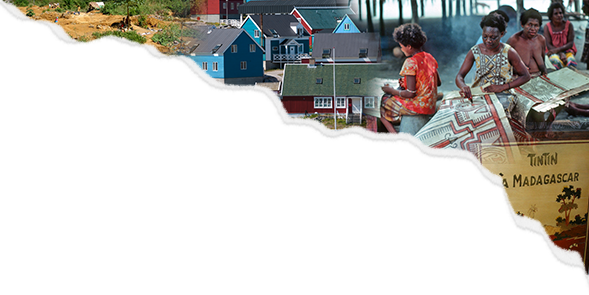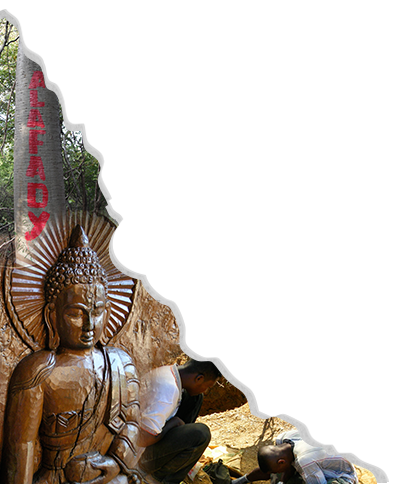In this post, series editor John Barker reflects on his last trip to Uiaku, Papua New Guinea, thirteen years after the original publication of Ancestral Lines: The Maisin of Papua New Guinea and the Fate of the Rainforest. Like many anthropologists in the field, his trip was cut short by the global shutdown due to COVID-19.
March 2020. I had been in Uiaku for just over a week, but already established a pattern of sorts. Each evening after visitors had left, I’d sit on the verandah of the Maume Guest House, enjoying the light cooling breeze as I typed a text message to my wife Anne describing the events of the day. In the morning, after enjoying a breakfast prepared by my ‘daughter’ Annie, I’d cage a ride from my ‘son’ Arthur on a small outrigger canoe to cross the Vayova River that divided Uiaku from Ganjiga village. Once deposited safely, I’d walk through a grove of coconut palms to the broad black sand beach, striding up and down while holding out my cell phone in hopes of catching an elusive signal from the tower situated in the hills above Tufi, some 40 kilometres to the north.
When Anne and I last stayed in Uiaku, in June 2007, cell phones were just being introduced to Papua New Guinea. Now cheap phones were ubiquitous, even in the village, despite the poor connectivity. The other big technological change was the solar panels. As I walked through the village, I saw them everywhere, lying in sunny patches near the houses. While the bush houses looked much the same, at night it was startling to see intense white light beaming from porch rafters rather than the dim kerosene lamps of the recent past. Two other changes stood out. The first was environmental. In November 2007, much of Oro Province suffered extreme flooding from Cyclone Guba. Southern Collingwood Bay was particularly hard hit, with entire villages being washed out and gardens buried under mud and debris. The Vayova River shifted course. While the gardens had fully recovered, the landscape thirteen years later looked very different. Several families at the northern end where the river had eroded the sandbar relocated across the river. A wide muddy field of sea grass separated the rest of the village from the water. Further up the coast, other Maisin villages were experiencing severe coastal erosion, forcing relocation inland. Much of our evening chats were taken up with talk about these changes and the increasing threats from climate change.
The other big change was demographic. Having had early access to education, the Maisin benefited from a boom in jobs across Papua New Guinea during the late colonial and earlier Independence period leading to a large out-migration of young people to urban centres. When we first arrived in the early 1980s, the village was home to relatively few young families. Some people worried that Uiaku was destined to be abandoned. Instead, the population has since boomed, a reflection not just of the declining job market but of a more general rejection of urban living which has become increasingly tenuous and violent for many Papua New Guineans. The Maisin population in March 2020 was young—very young. The schools at Uiaku and Airara had opened new classrooms to accommodate the growing numbers.
Returning for what I knew might well be my last visit occasioned joy, sharing memories with old friends and tears over the elders who have passed. It was also kind of cool, if initially off-putting, to be addressed as abu or bubu (grannie) by hordes of giggling children. While the opportunity to renew connections was wonderful, my main purpose was to bring copies of Ancestral Lines as gifts for those who had aided me the most, not least my research assistants Macsherry Gegeyo and Roland Yega, and as resources for the two schools. I also brought thumb drives containing Anne’s and my photographs and publications, as well as copies of documentaries shot over the years about the Maisin people but never made available for them to see. I left these with the two headmasters with instructions that they be made available to villages with laptops—a small act of repatriation. For several years, I’ve curated a site with these and additional materials: themaisinarchives.org. It’s often accessed by Maisin living in the towns. Hopefully soon, as internet access improves, it will be available to villagers as well.
But back to the Ganjiga beach that cloudy day in mid-March 2020. Flailing my arm about, I at last heard a satisfying ping, a text from Anne. It read, “the Canadian-US border has been closed.” As I stared at the screen in shock, the phone pinged again. “You need to come home NOW.” The convoluted antics of my return home is a story for another day. Suffice to say that it entailed an extremely anxious stay in Port Moresby wondering if it was going to become my long-term home as the world seemingly shut down and, a week or so later, an elusive search for food in a ghostly empty Vancouver International Airport.
Anthropologists used to write about people like the Nuer or the Trobriand Islanders as if they existed frozen in time. We don’t do that anymore, but inevitably describing a particular people or place lends an impression of permanence. Each time I’ve revisited Uiaku and other Maisin communities, I’m reminded that books like Ancestral Lines document moments in time. As a researcher, you try to distinguish between things that last, like key cultural orientations, and things that can quickly change, like people’s livelihoods when hit by environmental disaster. While the Maisin have faced many challenges over the past century, they’ve demonstrated a remarkable ability to unify and come to each other’s aid when faced by crises such as the global influenza pandemic of 1918-19 or the relentless attempts by commercial logging companies to gain access to the rainforest on which they depend. In Ancestral Lines, I argued that their beautiful tapa cloth symbolized that strength and continuity. After Guba, it has become much harder to find sandy dry soil to cultivate the mulberry trees from which tapa is made. Yet, in the 2020s, Uiaku women still beat tapa and tapa remains a powerful symbol of Maisin identity and resilience (just Google “Maisin Papua New Guinea” and check out the images that pop up). As we approach 2022, forty years since my first fieldwork, the Maisin face their greatest challenges yet as they continue to fight to retain control over their ancestral lands, adapt to climate change, and save their communities from the ravages of COVID-19. They are not alone and we have much to learn from them.
John Barker is a Professor Emeritus in the Department of Anthropology at the University of British Columbia.






